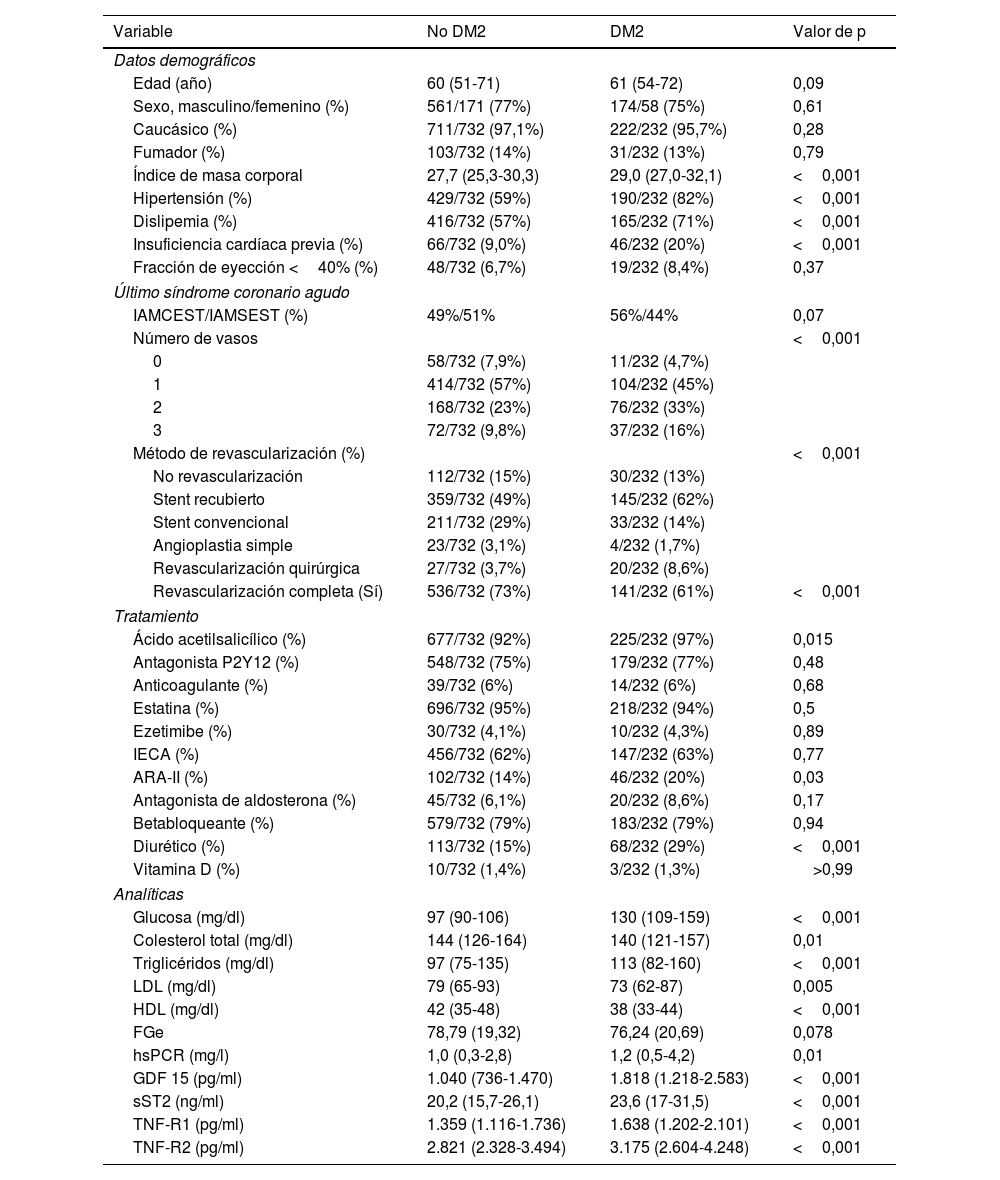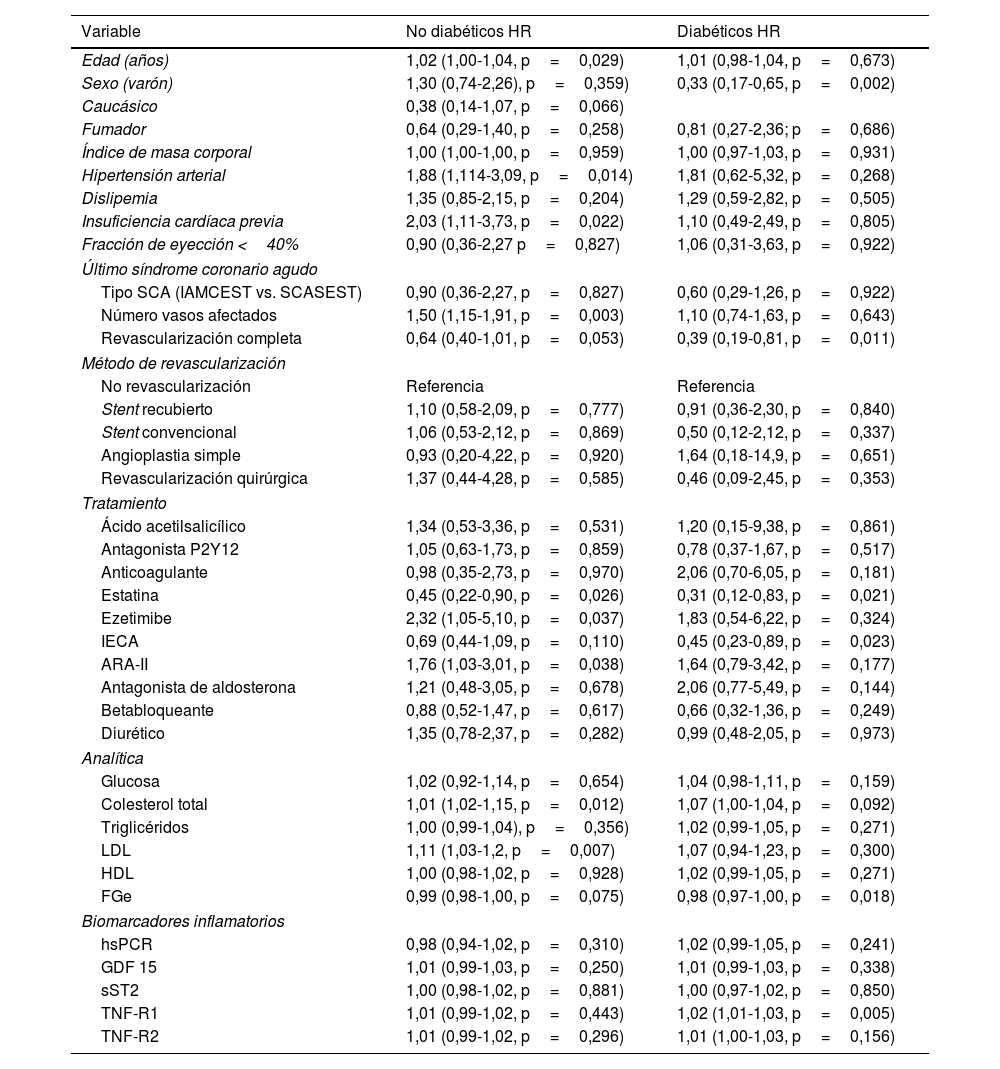Examinar la relación entre biomarcadores inflamatorios y la aparición de eventos cardiovasculares en pacientes con diabetes mellitus tipo 2 (DM2) y enfermedad coronaria estable.
Material y métodosSe incluyeron 964 pacientes con enfermedad coronaria estable. Se midieron los niveles plasmáticos de los marcadores inflamatorios: receptores del factor de necrosis tumoral 1 y 2 (TNF-R1 y TNF-R2), factor de diferenciación del crecimiento-15 (GDF-15), supresión de la tumorigenicidad 2 soluble (sST2) y proteína C reactiva de alta sensibilidad (hsPCR). El objetivo primario fue el desarrollo de eventos isquémicos agudos (síndrome coronario agudo de cualquier tipo, ictus o accidente isquémico transitorio).
ResultadosHabía 232 pacientes diabéticos y 732 no diabéticos. Los pacientes con enfermedad coronaria y DM2 (232, 24%) presentaron niveles más elevados de TNF-R1, TNF-R2, GDF-15 y sST2 (p<0,001) y de hsPCR que los pacientes sin DM2, lo que sugería la presencia de un mayor estado inflamatorio. Tras 5,39 (2,81-6,92) años de seguimiento, los pacientes con DM2 desarrollaron más frecuentemente el objetivo primario (15,9 vs. 10,8%; p=0,035). Los niveles plasmáticos de TNF-R1 fueron predictores independientes del objetivo primario en los pacientes con DM2 junto al género masculino, los niveles de triglicéridos o la ausencia de tratamiento con inhibidores de la enzima convertidora de la angiotensina. Ningún marcador inflamatorio predijo el desarrollo de este evento en pacientes no diabéticos.
ConclusionesLos pacientes con enfermedad coronaria y DM2 muestran niveles aumentados de los marcadores proinflamatorios TNF-R1, TNF-R2, GDF-15 y sST2. Además, los niveles de TNFR1 son predictores independientes de eventos isquémicos agudos únicamente en pacientes diabéticos.
To examine the relationship between inflammatory biomarkers and the occurrence of cardiovascular events in patients with type 2 diabetes mellitus (DM2) and stable coronary artery disease.
MethodsA total of 964 patients with stable coronary artery disease were included. Plasma levels of inflammatory markers, including tumour necrosis factor receptors 1 and 2 (TNF-R1 and TNF-R2), growth differentiation factor-15 (GDF-15), soluble suppression of tumorigenicity 2 (sST2), and high-sensitivity C-reactive protein (hsCRP) were measured. The primary endpoint was the development of acute ischaemic events (any type of acute coronary syndrome, stroke, or transient ischaemic attack).
ResultsThere were 232 diabetic patients and 732 non-diabetic patients. Patients with coronary artery disease and DM2 (232, 24%) had higher levels of TNF-R1, TNF-R2, GDF-15, sST2 (P<.001), and hsCRP compared to patients without DM2, indicating a higher inflammatory state. After a median follow-up of 5.39 (2.81-6.92) years, patients with DM2 more frequently developed the primary endpoint (15.9% vs 10.8%; P=.035). Plasma levels of TNF-R1 were independent predictors of the primary endpoint in patients with DM2, along with male gender, triglyceride levels, and the absence of treatment with angiotensin-converting enzyme inhibitors. None of these inflammatory markers predicted the development of this event in non-diabetic patients.
ConclusionsPatients with stable coronary artery disease and DM2 exhibit elevated levels of the proinflammatory markers TNF-R1, TNF-R2, GDF-15, and sST2. Moreover, TNF-R1 is an independent predictor of acute ischaemic events only in diabetic patients.








